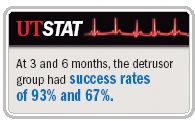Article
Botulinum toxin in overactive bladder: The site makes a difference
Where botulinum toxin A (Botox) is injected to treat idiopathic detrusor overactivity makes a difference-not right away, but in the long term.

Keypoints:

That was the major finding of a prospective study of botulinum toxin A injection for this disorder in 45 patients refractive to antimuscarinic therapy who were treated by Hann-Chorng Kuo, MD, professor and chief, department of urology, Buddhist Tzu Chi General Hospital and Tzu Chi University, Hualien, Taiwan. The team compared results of injections into the detrusor, the suburothelial space, and the bladder base.

Success at detrusor

Improvements in quality of life scores were similar among the groups, (93%, 80%, and 87%). Overall satisfaction (80%, 67%, 47%) was lowest in the bladder base group, but the difference did not reach statistical significance. The bladder base injections eased sensations of urgency, lowered the incidence of difficult urination, and increased postvoid residual urine, but they produced only a limited increase in bladder capacity, Dr. Kuo noted.
He said these results suggest that a better therapeutic effect can be achieved with injection into the bladder body (including detrusor and suburothelial injection groups) than into the bladder base. Overactivity may have different etiologies, including increased afferent input from the suburothelium, increased excitability of the detrusor, and increased sensitivity from the bladder base and trigonal afferents, so combining all these methods might target all potential sources.
In response to a question of why some earlier studies of botulinum toxin A injection weren't successful, Dr. Kuo said that the dose may have been inadequate, incorrect sites may have been injected, or patients may have had occult central nervous system lesions, rather than detrusor overactivity, that caused their symptoms.
Dr. Kuo suggested that for patients with sensory urgency alone, bladder base injection might be successful.





